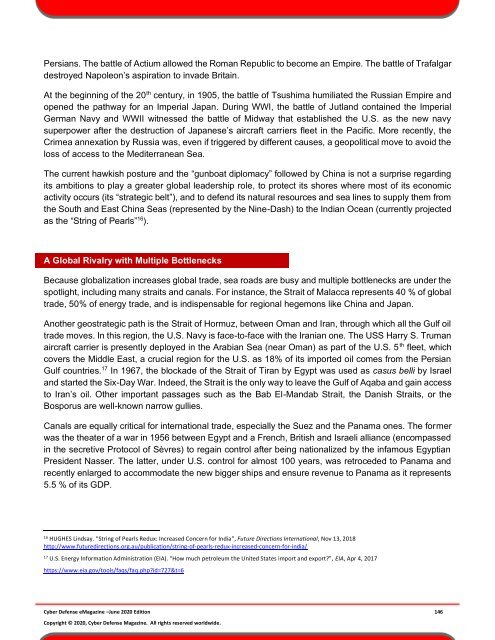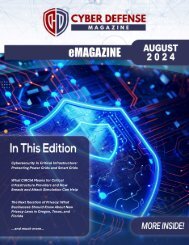Cyber Defense eMagazine June 2020 Edition
Cyber Defense eMagazine June Edition for 2020 #CDM #CYBERDEFENSEMAG @CyberDefenseMag by @Miliefsky a world-renowned cyber security expert and the Publisher of Cyber Defense Magazine as part of the Cyber Defense Media Group as well as Yan Ross, US Editor-in-Chief, Pieruligi Paganini, Co-founder & International Editor-in-Chief, Stevin Miliefsky, President and many more writers, partners and supporters who make this an awesome publication! Thank you all and to our readers! OSINT ROCKS! #CDM #CDMG #OSINT #CYBERSECURITY #INFOSEC #BEST #PRACTICES #TIPS #TECHNIQUES
Cyber Defense eMagazine June Edition for 2020 #CDM #CYBERDEFENSEMAG @CyberDefenseMag by @Miliefsky a world-renowned cyber security expert and the Publisher of Cyber Defense Magazine as part of the Cyber Defense Media Group as well as Yan Ross, US Editor-in-Chief, Pieruligi Paganini, Co-founder & International Editor-in-Chief, Stevin Miliefsky, President and many more writers, partners and supporters who make this an awesome publication! Thank you all and to our readers! OSINT ROCKS! #CDM #CDMG #OSINT #CYBERSECURITY #INFOSEC #BEST #PRACTICES #TIPS #TECHNIQUES
You also want an ePaper? Increase the reach of your titles
YUMPU automatically turns print PDFs into web optimized ePapers that Google loves.
Persians. The battle of Actium allowed the Roman Republic to become an Empire. The battle of Trafalgar<br />
destroyed Napoleon’s aspiration to invade Britain.<br />
At the beginning of the 20 th century, in 1905, the battle of Tsushima humiliated the Russian Empire and<br />
opened the pathway for an Imperial Japan. During WWI, the battle of Jutland contained the Imperial<br />
German Navy and WWII witnessed the battle of Midway that established the U.S. as the new navy<br />
superpower after the destruction of Japanese’s aircraft carriers fleet in the Pacific. More recently, the<br />
Crimea annexation by Russia was, even if triggered by different causes, a geopolitical move to avoid the<br />
loss of access to the Mediterranean Sea.<br />
The current hawkish posture and the “gunboat diplomacy” followed by China is not a surprise regarding<br />
its ambitions to play a greater global leadership role, to protect its shores where most of its economic<br />
activity occurs (its “strategic belt”), and to defend its natural resources and sea lines to supply them from<br />
the South and East China Seas (represented by the Nine-Dash) to the Indian Ocean (currently projected<br />
as the “String of Pearls” 16 ).<br />
A Global Rivalry with Multiple Bottlenecks<br />
Because globalization increases global trade, sea roads are busy and multiple bottlenecks are under the<br />
spotlight, including many straits and canals. For instance, the Strait of Malacca represents 40 % of global<br />
trade, 50% of energy trade, and is indispensable for regional hegemons like China and Japan.<br />
Another geostrategic path is the Strait of Hormuz, between Oman and Iran, through which all the Gulf oil<br />
trade moves. In this region, the U.S. Navy is face-to-face with the Iranian one. The USS Harry S. Truman<br />
aircraft carrier is presently deployed in the Arabian Sea (near Oman) as part of the U.S. 5 th fleet, which<br />
covers the Middle East, a crucial region for the U.S. as 18% of its imported oil comes from the Persian<br />
Gulf countries. 17 In 1967, the blockade of the Strait of Tiran by Egypt was used as casus belli by Israel<br />
and started the Six-Day War. Indeed, the Strait is the only way to leave the Gulf of Aqaba and gain access<br />
to Iran’s oil. Other important passages such as the Bab El-Mandab Strait, the Danish Straits, or the<br />
Bosporus are well-known narrow gullies.<br />
Canals are equally critical for international trade, especially the Suez and the Panama ones. The former<br />
was the theater of a war in 1956 between Egypt and a French, British and Israeli alliance (encompassed<br />
in the secretive Protocol of Sèvres) to regain control after being nationalized by the infamous Egyptian<br />
President Nasser. The latter, under U.S. control for almost 100 years, was retroceded to Panama and<br />
recently enlarged to accommodate the new bigger ships and ensure revenue to Panama as it represents<br />
5.5 % of its GDP.<br />
16<br />
HUGHES Lindsay. “String of Pearls Redux: Increased Concern for India”, Future Directions International, Nov 13, 2018<br />
http://www.futuredirections.org.au/publication/string-of-pearls-redux-increased-concern-for-india/<br />
17<br />
U.S. Energy Information Administration (EIA). “How much petroleum the United States import and export?”, EIA, Apr 4, 2017<br />
https://www.eia.gov/tools/faqs/faq.php?id=727&t=6<br />
<strong>Cyber</strong> <strong>Defense</strong> <strong>eMagazine</strong> –<strong>June</strong> <strong>2020</strong> <strong>Edition</strong> 146<br />
Copyright © <strong>2020</strong>, <strong>Cyber</strong> <strong>Defense</strong> Magazine. All rights reserved worldwide.


















